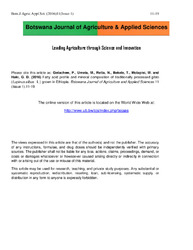Fatty acid profile and mineral composition of traditionally processed gibto (Lupinus albus L.) grown in Ethiopia

View/
Date
2016Author
Getachew, P.
Umeta, M.
Retta, N.
Bekele, T.
Molapisi, M.
Haki, G. D.
Metadata
Show full item recordAbstract
White lupin seeds, Lupinus albus L. are known for their bitter taste due to the presence of various alkaloids and other related anti-nutritional factors which make the seeds inedible. There are some traditional processing methods that have the potential to reduce the alkaloid content and make the product safe for human consumption. However, studies on the effects of these processing techniques on other biochemical compositions of the seed are lacking. In this study, the effects of three commonly used traditional processing methods on the fatty acid profile, mineral composition and total alkaloid contents of L. albus seeds grown in Ethiopia are reported. The processing methods comprised boiling followed by soaking for five days, roasting followed by soaking for five days and germination for 48 hours, each combined with dehulling by hand, at the end of the processing treatment. The L. albus seeds were collected from two sites named Dangla and Tilili. Analysis of the seeds showed that the contents of iron, zinc, manganese and magnesium in the raw Dangla and Tilili samples were 6.01, 2.11, 58.43 and 8.93 mg/100 g and 6.73, 1.81, 59.14 and 9.46 mg/100 g, respectively. In raw seeds, an average value of 10% saturated and 75% unsaturated fatty acids were recorded. The predominant saturated fatty acids were C16:0, C18:0 and C20:0 while the unsaturated fatty acids were C18:1 (n-9) and C18:2 (n-6). All the traditional processing methods applied reduced the total alkaloid content of the seed from both sites significantly. Due to these treatments the content of iron in the seeds from both sites was reduced by between 14 and 47% and magnesium by less than 10%. However, no reduction in essential fatty acid contents was observed. Therefore, minimal processing of L. albus seeds using traditional methods can serve as a means of reducing alkaloid content and thus allow the product, which is a potential source of minerals and essential fatty acids, to be palatable to humans.
